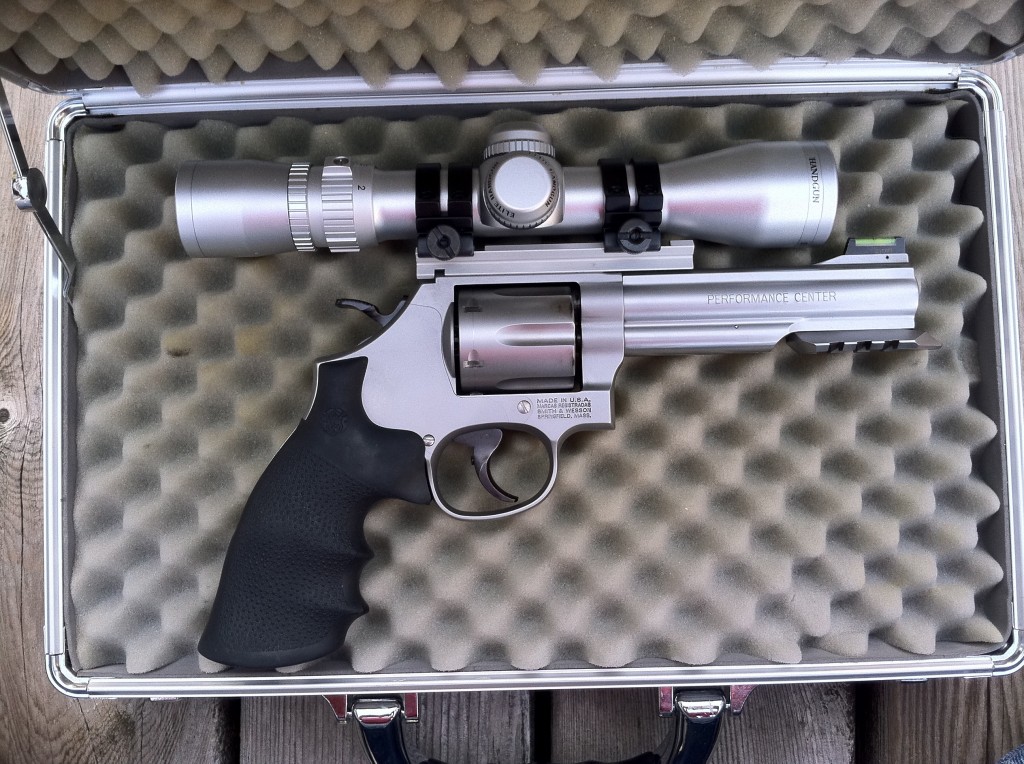 Confession: I’ve wanted a huge-ass Smith & Wesson scoped revolver ever since the first time I saw The Road Warrior in junior high school. I know they shouldn’t have let us in to see an R-rated movie, but money talks and the MPAA sucks. Lord Humongous might have terrorized the Simpson Desert with his .44 Magnum Model 29, but if I owned a Performance Center 686 with a scope like this I wouldn’t swap guns with him for all the opals in Coober Pedy . . .
Confession: I’ve wanted a huge-ass Smith & Wesson scoped revolver ever since the first time I saw The Road Warrior in junior high school. I know they shouldn’t have let us in to see an R-rated movie, but money talks and the MPAA sucks. Lord Humongous might have terrorized the Simpson Desert with his .44 Magnum Model 29, but if I owned a Performance Center 686 with a scope like this I wouldn’t swap guns with him for all the opals in Coober Pedy . . .
THE GUN:
This Performance Center 686 comes with a Lincoln Navigator full of factory bling: an extra-wide target hammer spur, a wide smooth trigger with adjustable overtravel, a tuned action with a four-pound S/A trigger pull, a green fiber-optic front sight, a special-cut muzzle crown, and a combination bottle-opener, cheese-grater, Picatinny rail and emergency window shatterer under the muzzle. How does it look? Like a special bonus gun from Fallout 3: New Vegas, baby.
This bonus gun definitely comes with an accuracy multiplier: in single-action mode the trigger breaks with absolute precision at exactly four pounds with no takeup and no overtravel. Shooting just about any ammo you have on hand, you’ll be amazed by 0.75″ groups at 25 yards until you start to get used to the trigger and the scope. After that you’ll probably save your amazement for 25 yard cloverleaf groups like this:
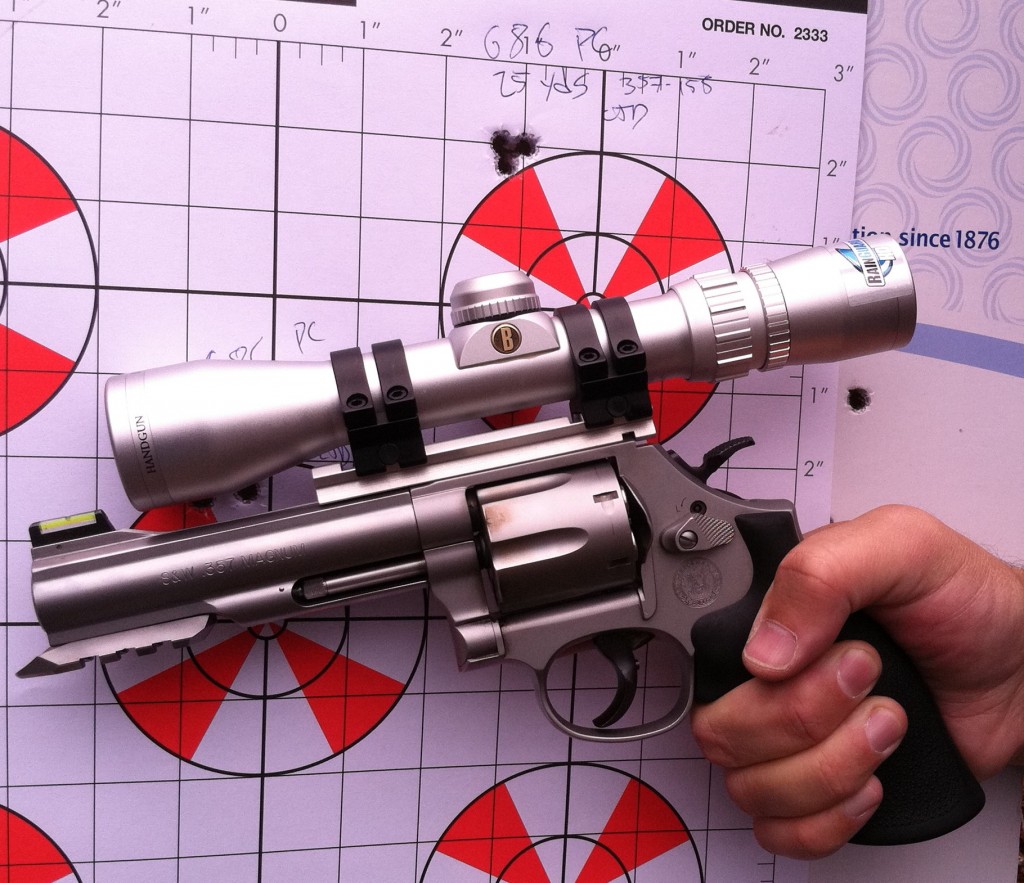 Why a three-shot group? Because this bad boy behaves more like a rifle than any handgun you’ve ever shot. Unless you’ve got a T/C Encore, but then you’ll already know what I mean. And if you haven’t got a T/C Encore, you’ve probably never seen 50-yard pistol groups like these:
Why a three-shot group? Because this bad boy behaves more like a rifle than any handgun you’ve ever shot. Unless you’ve got a T/C Encore, but then you’ll already know what I mean. And if you haven’t got a T/C Encore, you’ve probably never seen 50-yard pistol groups like these: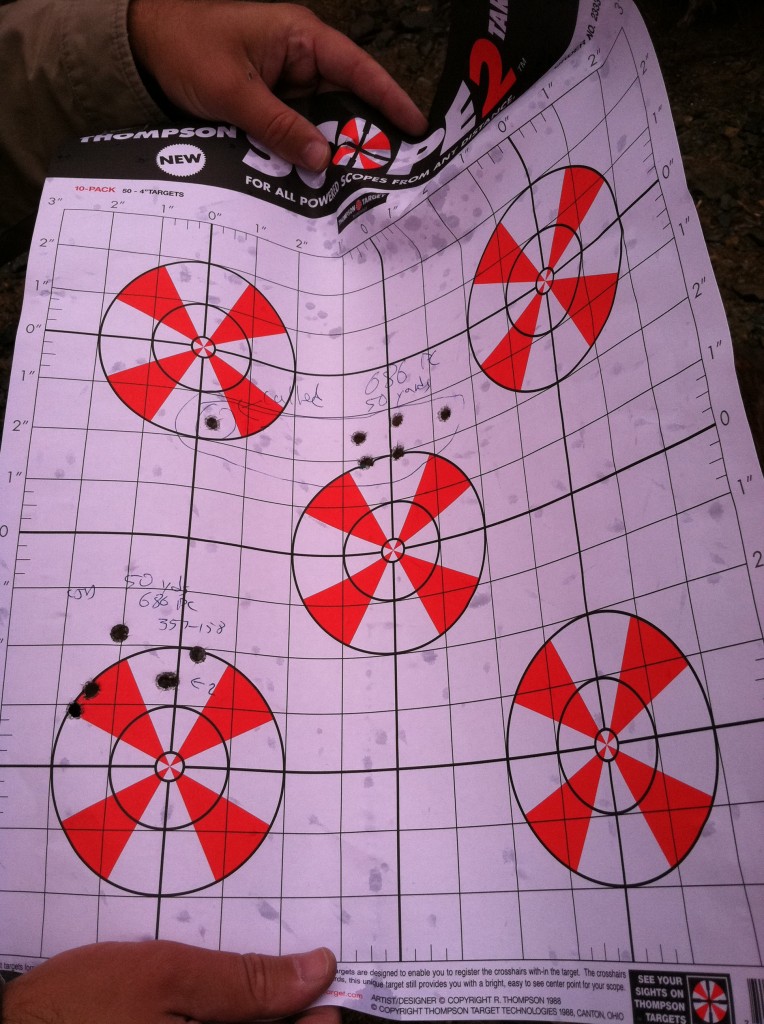 I pulled that bad shot in the top group, and I knew it before I even spotted the shot through the scope. There’s always some debate about what to do with ‘fliers’, because if you take too many Mulligans it gives you an invalid data set (ask Foghorn) and tends to make bad guns and bad shooters look a lot better than they really are. I’ll leave that discussion for another day and another gun, because that one bad shot was the only flier the 686 gave us all day, through more than 100 rounds fired.
I pulled that bad shot in the top group, and I knew it before I even spotted the shot through the scope. There’s always some debate about what to do with ‘fliers’, because if you take too many Mulligans it gives you an invalid data set (ask Foghorn) and tends to make bad guns and bad shooters look a lot better than they really are. I’ll leave that discussion for another day and another gun, because that one bad shot was the only flier the 686 gave us all day, through more than 100 rounds fired.
Revolver accuracy can sometimes be enhanced by firing from only one chamber, since this eliminates the variables of cylinder timing and cylinder chamber concentricity. Wayne and I didn’t go in for any of this silliness, however. We just loaded the 686 and shot it like a silhouette shooter or hunter would do. I lack the machining instruments to test my theory, but I’d bet that this 686’s cylinder is nearasdammit perfectly concentric, and that the chambers are also bored and indexed perfectly concentric to the bore.
Our longer-range testing was made easy when we found the most perfect pistol-shooting rest ever in the whole history of ever: a tree-root snag with an angled stump at the perfect height to be a standing bench rest.
 This shot captures the 686 in ‘full’ recoil, which isn’t much. Even with the loose-fisted and limp-wristed grip that gave me the best long-range accuracy, the enormous (57-ounce) .357 was anything but punishing.
This shot captures the 686 in ‘full’ recoil, which isn’t much. Even with the loose-fisted and limp-wristed grip that gave me the best long-range accuracy, the enormous (57-ounce) .357 was anything but punishing.
The bottom line: this Performance Center 686 is the most accurate centerfire pistol I’ve ever shot, and I’ve shot a lot. It would kick unmitigated ass in the revolver class of any bullseye or silhouette competition where scopes are allowed. Zeroed two inches high at 50 yards, it should place your bullet within a few inches of your point of aim at 100 yards. (Sadly, we were prevented from testing at that ridiculous distance when our intermittent Northwest drizzle solidified into a steady rain.)
Ergonomics:
For a big-ass revolver with no defensive or ‘tactical’ pretensions, this Performance Center 686 has it goin’ on. The trigger pull is, as I mentioned, superb, and so is the trigger itself. It’s wide and smooth and features a tiny Allen screw at the back end.
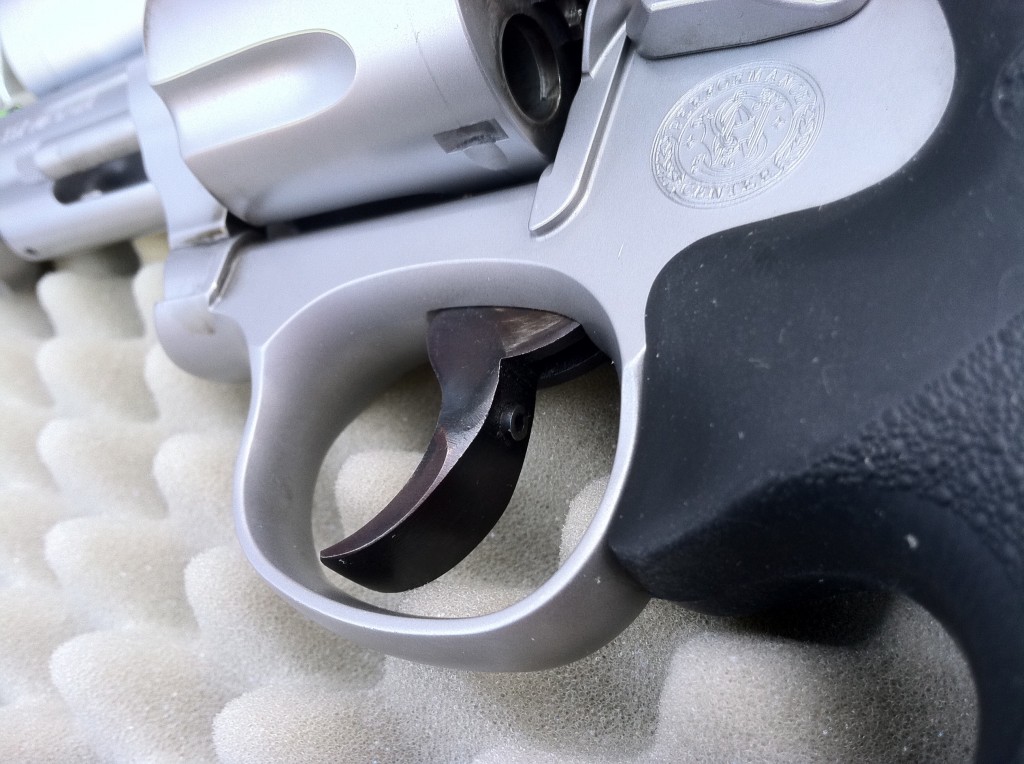 Screw it in all the way and you start to notice some overtravel. Screw it out too far and the gun won’t fire. Screw it back in just right, however, and the trigger travel stops the instant the sear lets go. This keeps the gun steadier as the hammer falls and the bullet heads downrange, and gives ever-so-slightly increased accuracy.
Screw it in all the way and you start to notice some overtravel. Screw it out too far and the gun won’t fire. Screw it back in just right, however, and the trigger travel stops the instant the sear lets go. This keeps the gun steadier as the hammer falls and the bullet heads downrange, and gives ever-so-slightly increased accuracy.
The hammer has a wide, checkered spur which makes the gun easy to cock and fire single-action, even with a large scope like the Bushnell mounted above it. The Hogue-style stippled rubber grips were a perfect fit for my medium-large paws, and their soft surface gave me a very secure grip even while shooting in the rain.
This gun shoots and handles so well that I can find only one ergonomic critique: it’s probably a real bitch to carry in the field. At just a nudge over 3.5 pounds scoped and loaded, it would be fatiguing (and eventually unsafe) to trudge over hill and dale carrying it in hand. The scope would require a special crossdraw or shoulder holster.
Reliability:
The Performance Center 686 loaded easily, fired perfectly, and ejected smoothly for us. If it did that for several more boxes of ammo I’d give it five stars, but I know that the model has a less-than-perfect history of reliability: a non-PC Smith & Wesson 686 4″ jammed up solidly on Farago when the infernal internal safety lock failed. The past notwithstanding, this gun gave us no problems through more than 100 rounds fired. Two boxes of ammo isn’t enough to prove a gun’s reliability, so I’ll withhold judgment except to say that the locked-up trigger seems to have been repaired properly.
Ballistics:
From my experience with the astounding ballistics of .357 Magnum carbines, I was hoping that the 686’s six-inch barrel would give its bullets a little extra oomph downrange. After all, every inch of barrel (in theory) is another ten-thousandth of a second for combustion pressures to rise and bullet velocity to increase.
We ain’t Mythbusters, but we put this theory to the test with our Shooting Chrony chronograph. We compared the muzzle velocity of 158-grain Fiocchi and 125-grain Winchester PDX ammo, using a 3-inch S&W Model 60, a 4-inch Model 686 and the 6-inch Performance Center 686. (Warning: boring technical details ahead.)
Bullet/Gun 60-3″ 686-4″ 686-6″ (this gun)
125-gr 1140 1244 1187
158-gr 1015 1090 1031
Obviously none of these loads are hotrods, but we were both surprised that the Performance Center 686 produced consistently lower velocities than the shorter-barrel 686-4, and barely edged out the almost-snubnose Model 60.
The rain ended our testing before I could dredge up my hotrod handloads. With a near-maximum charge of slow-burning Vitavhouri powder, they should have benefited the most from the longer barrel. I wouldn’t have shot them through the Model 60 (ouch!) but they might have hinted at the reason behind these counter-intuitive ballistic results.
If the Performance Center 686 outperformed the 686-4 with slow-burning powder, that would have shown that our chronographed test ammo used quick-burning powders optimized for short barrels. If the 686-4 outperformed the Performance Center 686, it would indicate that the latter pistol has an excessive cylinder gap.
Conclusion:
This Performance Center 686 is an extremely accurate, comfortable full-size revolver. Personal attention from experienced gunsmiths doesn’t come cheaply, and this pistol demonstrates just what you get when you drop the extra Benjamins for some factory TLC. It runs like a Swiss watch, and shows a nearly-unheard of level of fit and finish on all its critical parts and surfaces.
It’s a masterpiece, but it’s not all guns to all people. Even without a scope it’s too large to carry for defensive use, although it could be pressed into service as a nightstand gun. It’s a refined and specialized tool for bullseye and silhouette target shooting and hunting small and medium game.
The moderate power of its .357 Magnum chambering makes it a poor choice for big-game hunting, but anything smaller will fall to its superb accuracy when paired with a high-quality handgun scope like the Bushnell Elite. With mild loads it could harvest rabbits and squirrels out to 50 yards, and coyotes out to 100 yards and beyond.
THE SCOPE:
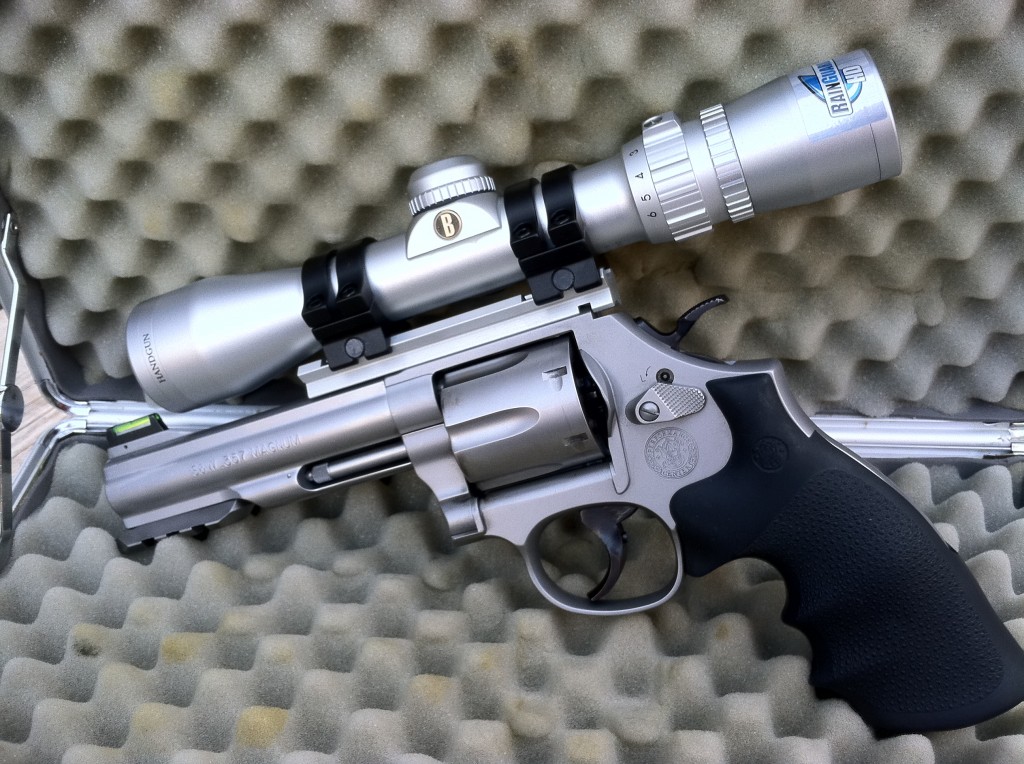 Our long-range accuracy testing was also made easier (actually, it was made possible) by the Bushnell Elite 2-6×32 handgun scope. Instead of squinting over clumsy iron sights at impossibly distant targets, the Bushnell Elite made our 50-yard shooting easier than bullseyeing Womp Rats from our T-16s back on Tatooine. In fact, it wasn’t much trickier than blasting tin cans at 50 yards with a scoped .22 rifle.
Our long-range accuracy testing was also made easier (actually, it was made possible) by the Bushnell Elite 2-6×32 handgun scope. Instead of squinting over clumsy iron sights at impossibly distant targets, the Bushnell Elite made our 50-yard shooting easier than bullseyeing Womp Rats from our T-16s back on Tatooine. In fact, it wasn’t much trickier than blasting tin cans at 50 yards with a scoped .22 rifle.
At 9.5 inches long and weighing 10 ounces, this scope is the same size and weight as a compact rifle scope. Four-inch barreled pistols probably need not apply, since you don’t want the scope tube to get scorched and fouled by muzzle gasses.
At low magnification the enormous (for a handgun) 32mm objective gives the glass exceptional brightness and a comfortably large sweet spot. It has a constant eye relief of exactly 20 inches: hold the scope a little too close or a little too far out, and it gets tricky to find the sweet spot.
Because of its 20-inch eye relief, the Bushnell Elite is a ‘Handgun’ scope only, and it isn’t a good choice for an intermediate eye-relief ‘Scout’ scope. Most scout scopes have eye relief of approximately 10 inches for mounting just forward of a rifle’s receiver, but the Bushnell would have to be mounted almost near a rifle’s muzzle. That would screw up any rifle’s handling, so why bother? There are better choices for scout scopes out there.
Here’s a video of looking through the Bushnell Elite. Ignore the apparent spherical ‘bubble’ astigmatism in this video: it only appears at extremely short ranges and vanishes completely by 15 yards.
The turret covers screw down tightly onto thick gaskets, as part of the Elite’s heavily-advertised waterproofing. As far as I could tell, it works pretty well. Wayne and I shot all morning in a drizzle which turned at times into a steady light rain, and our Northwest weather didn’t fog up the scope in the slightest. The water-repelling lens coating, called RainGuard HD, seems to work well. The scope arrived with some condensation droplets on the objective which easily wiped off, as did the constant barrage of mist and raindrops that fell on the eyepiece during testing.
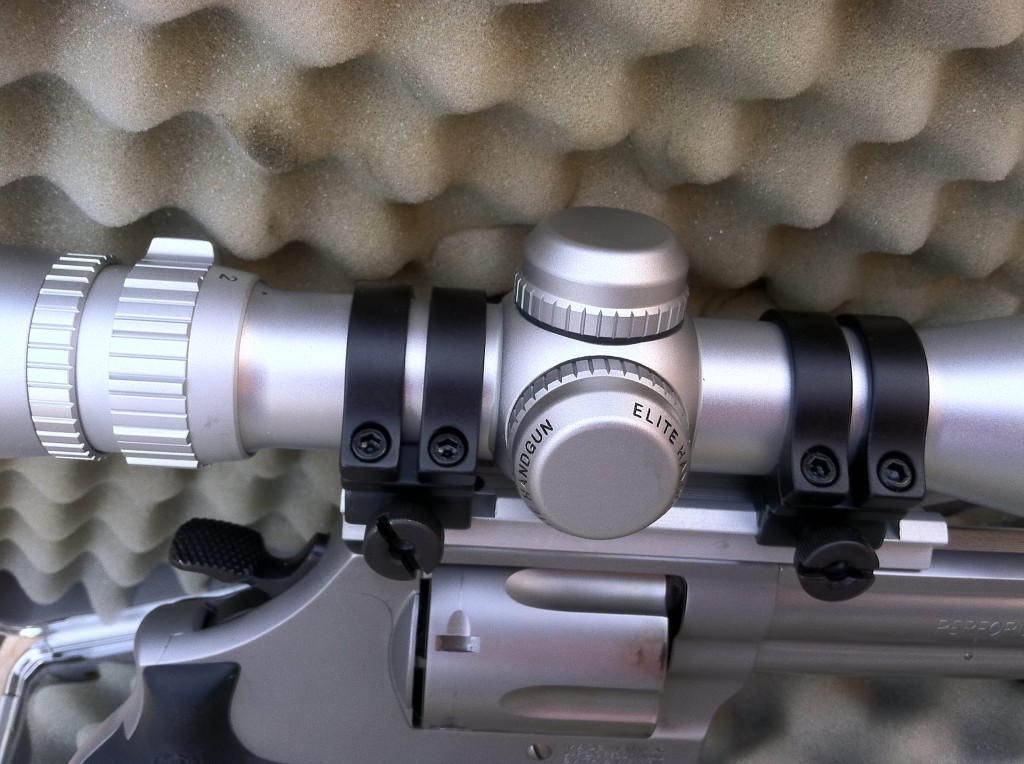 The covers are knurled a little bit, but they ought to be textured more aggressively since they’re a bit tough to unscrew, particularly with wet or cold fingers. Once they are unscrewed, your fingernails are safe: the windage and elevation dials are finger-adjustable, with positive 1/4-inch clicks at 100 yards. These adjustments are a little too precise for a dedicated handgun scope; I lost track of how many clicks I had to use to move the point of impact an few inches at 15 yards. Zeroing a handgun would be easier with 1/2-inch clicks at 100 yards. I doubt accuracy would suffer since 1/2 MOA accuracy with a handgun at that distance is nearly impossible anyway.
The covers are knurled a little bit, but they ought to be textured more aggressively since they’re a bit tough to unscrew, particularly with wet or cold fingers. Once they are unscrewed, your fingernails are safe: the windage and elevation dials are finger-adjustable, with positive 1/4-inch clicks at 100 yards. These adjustments are a little too precise for a dedicated handgun scope; I lost track of how many clicks I had to use to move the point of impact an few inches at 15 yards. Zeroing a handgun would be easier with 1/2-inch clicks at 100 yards. I doubt accuracy would suffer since 1/2 MOA accuracy with a handgun at that distance is nearly impossible anyway.
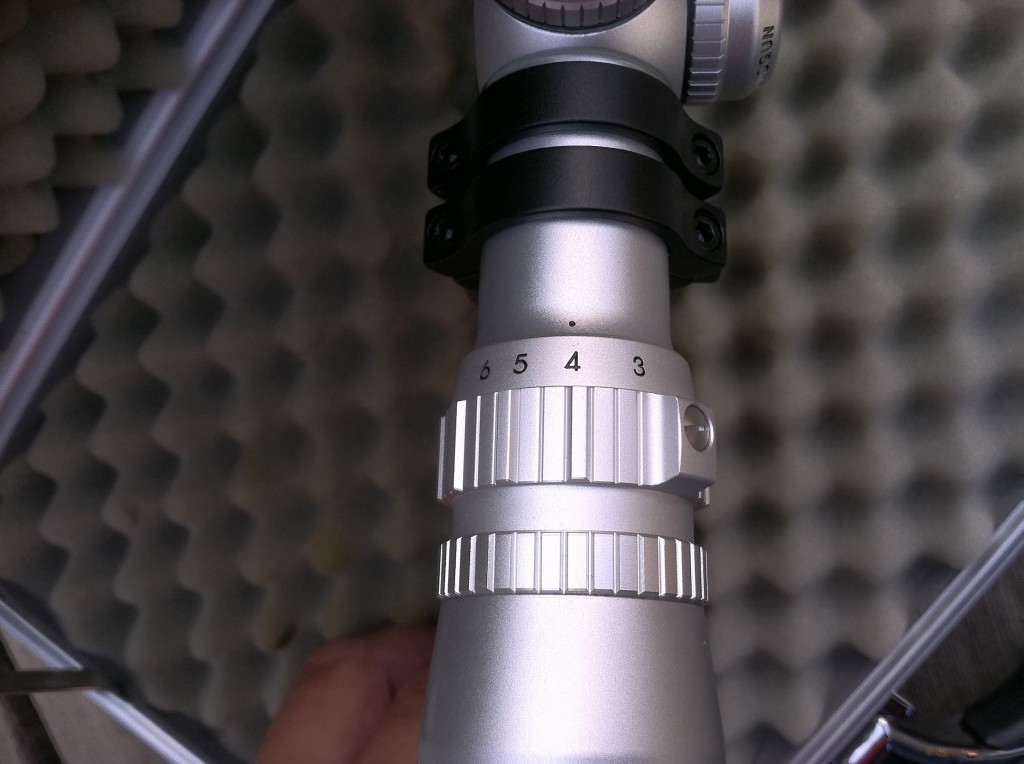 The magnification ring adjusts very smoothly, requiring nearly a half-turn to adjust from 2x to 6x. Other scopes don’t need such a long turn but Nigel Tufnel wouldn’t be impressed with them: they don’t go all the way to 11, er, 6.
The magnification ring adjusts very smoothly, requiring nearly a half-turn to adjust from 2x to 6x. Other scopes don’t need such a long turn but Nigel Tufnel wouldn’t be impressed with them: they don’t go all the way to 11, er, 6.
The Bushnell Elite showed no change of zero as we switched between 2x and 6x at ranges up to 25 yards. At 50 yards we switched it between 4x and 6x, and again the zero remained constant. It also showed no parallax from 7 yards out to 50 yards, and the point of impact remained constant even between different shooters.
Conclusion:
If our test sample is any indication, the Bushnell Elite 2-6×32 Handgun scope is a good-quality handgun scope that gets the job done, and done well, when mounted on an extremely accurate pistol like this Performance Center 686.
At a street price of $300 or less, it could be a welcome break from the conventional wisdom that you should spend nearly as much money on your scope as you spend on your gun. I can’t speak to its long-term recoil tolerance (and we couldn’t torture-test it on Joe Matafome’s monstrous .500 S&W) but Wayne and I let it flip around pretty vigorously on the 686 and it did nothing but perform as promised.
The Bushnell delivers variable power and a larger objective than any Leupold of similar price. Durability is everything in a handgun scope, however, and we just weren’t able to punish the Bushnell enough to prove it beyond a reasonable doubt.
SPECIFICATIONS
Caliber: .357 Magnum/.38 Special
Barrel: 6 inches
Weight: 3 lbs, 9 oz
Capacity: 6
Finish: Low-Gloss Stainless
Gun Price: No longer in production, but street price $800 and up.
Scope: 2-6 power variable, 32mm objective, 20 inches fixed eye relief, waterproof, satin stainless finish. Street price $280-300.
RATINGS WITH SCOPE (out of five)
Accuracy * * * * *
One-hole accuracy out to 25 yards is more accurate than some rifles. Wow.
Styling * * * * *
Lord Humongous eat your heart out.
Ergonomics * * * * *
With mild recoil, comfortable grips and a superb trigger, everything about this gun is optimized for comfortable and accurate long-range shooting.
Reliability * * * 1/2
Subtract a star and a half for its epic fail on a similar revolver earlier this year.
Customize This *
Already done. What moron would add a tactical light to a hunting pistol?
Overall Rating (Gun and Scope) * * * * 1/2
A unique and outstanding pistol. For a specialized hunting and competition tool, the only thing it lacks is more lb-ft of energy.
Overall Rating (Scope) * * * 1/2
This scope delivers plenty of features and proven performance at a reasonable price. Based solely on our experience with it, I would give it four and a half stars. Since durability is so important for handgun scopes, subtract a star for an unproven track record.


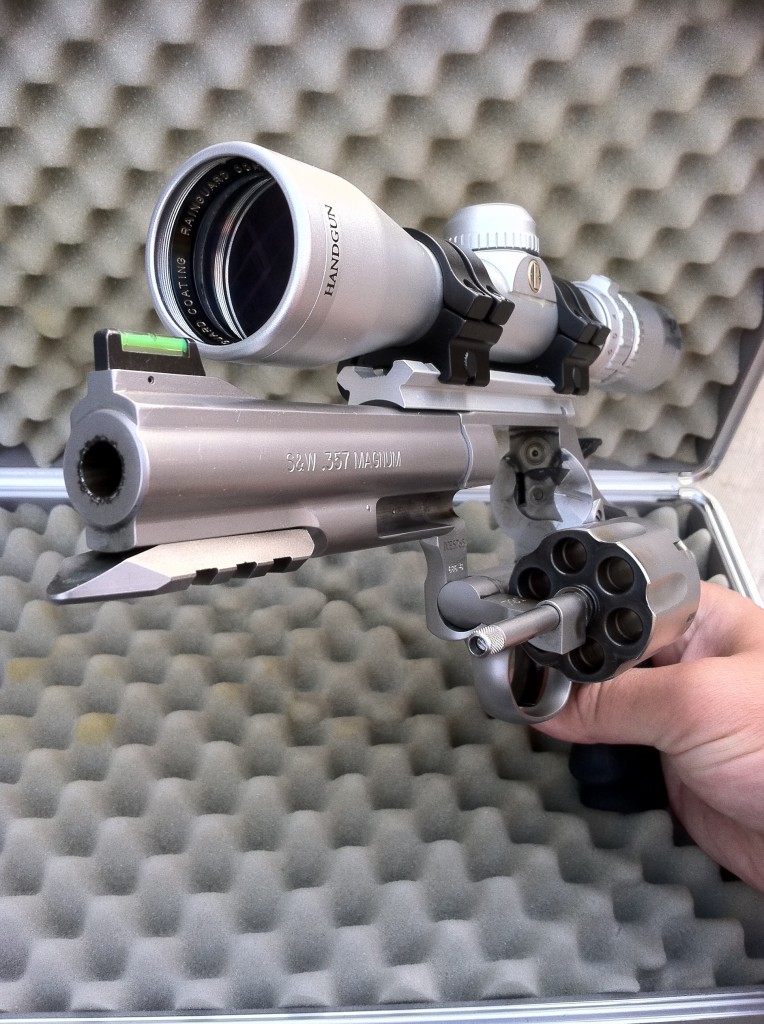



“What moron would add a tactical light to a hunting pistol”… perhaps hunters/trappers who stalk/hunt at night (where legal of course)?
Just walk awayyyyyyy
I have a Leupold 2×20 on my .44 Ruger and I like it very much. I could use a bit more magnification but for 50 yards it’s good enough. The .357 is a bit light for deer hunting IMHO
Getting ready for your new career as a NCR Ranger?
Good read, the whole scope on a pistol concept has always intrigued me. How practical is it in double action or somewhat rapid fire?
Just give me a plasma rifle and the 10mm pistol and I’m set!
Nice review about the SW. I had looked into getting Ruger’s GP100 .357 6″ barrels though having mid-size hands and build these monster handguns are a bit too beefy for me. The SW even weighs a bit more than the Ruger.
I carried both while in LE years ago. SW 686 was the better of the two IMHO.
Another great review, Chris. One question: can it core a apple, oh Chef of the Future? And can you use it for spearfishing?
+1 for the Honeymooners reference – hadn’t heard that one in years!
Beg pardon, but what is that horrendous rail slab hanging off the barrel and what does it need that point for?
The Wasteland is a harsh place and ammo is scarce, sometimes you have to jab supermutants and enclave soldiers to death.
Internal lock? Check. Checkbook? Back in pocket.
We didn’t shoot much in double-action, but at close range and low magnification it was a great plinking gun.
And Patrick, I wasn’t thinking of hunters when I wrote that. You’re right: Putting a super-bright light on this gun could actually make it a great (if unusual) night-time predator hunting gun. I’ve never lived in a state that allows that, so I tend to overlook night hunting as an option.
And Ralph: it can’t core an apple, but it can shred potatoes into tasty hash browns! I didn’t try to Julienne anything with it.
I just picked up a Ruger Super Blackhawk Bisley Hunter .44 today and wanted to get your opinion on that Bushnell Scope.. Yay or nay…? I have a 4X Simmons on my TC G2 Contender .30-30 Win Pistol and shoot sub-MOA at100 yards.
http://www.handgunhunt.com/photopost/member.php?uid=5856&protype=1
Just don’t want to let my self down in the optics department.
I really liked the scope, and my only reservation is that I wasn’t able to test it under any serious recoil. If I could have tested it with a few boxes of .44 Magnum, I wouldn’t have any more doubts about its durability.
Hi, this is a great post! Thanks..
The long and constant eye relief is a real plus on the Bushnell Elite. Very bright and clear glass.
I believe this is one of the so much significant info for me. And i am glad studying your article. But want to commentary on some general things, The web site taste is perfect, the articles is in reality nice : D. Just right process, cheers
Nice article. I picked up a used 686 competitor recently as an all around do anything gun- with the 6″ barrel and proper loads it could take deer sized game out to 100 yards, revolver would allow used of shotshells if desired, ,357mag is perhaps the most popular chambering (at least for a wheelgun). Loads can be made from barely 100 ft-lbs up to well over 600, bullet weights from 90gr (.356) to 200gr, handgun portable. And paired with a .357 carbine- truly a wonderful set.
Perhaps the 6″ is not the most portable size, but this is one gun that cn just about do it all for me. I’m a die hard fan of the .40S&W, i can make that sit up and beg almost as good as the .357 mag, but the S&W 686 allows serious range that few pistols could approach, and even then, it would not have the versatility.
too bad the .41 mag didn’t become as popular- but there are always tradeoffs.
I just find it funny that i have come to like revolvers so much.
It looks pretty, sure. But is it as handsome as the ranger sequoia?
This is my experience with the 686 line as well. I don’t think a lot of people realize how versatile a big-bore revolver is.
My 686P is not all tricked out, but it can put up 2″ groups at 25 yards all day. It seems to have a pretty strong preference for the 125g bullet weights, particularly the Remington Golden Sabers. For the range, .38SPL wadcutters are tons of fun.
I was in the market for a S&W Model 586 Classic .357 Magnum. What turned out to be available was a 4″ S&W 686. While testing the gun with 158 grain ammo, it jams up: https://www.youtube.com/watch?v=QZm1vy0GvEw
I am guessing it is the internal lock as well. The funny thing is, I can fire .38 or 125 grain .357 rounds without a problem. I’m wondering, while I’m waiting for S&W to email me return labels, whether I made the right choice. I wish I would have read more of this review BEFORE I bought this firearm. Still, it feels real good when it shoots…
That overtravel adjuster on the trigger is NOT an allen screw, it is nothing but a roll pin. The only way to adjust it is to file it down or insert a longer roll pin. S&W cheaped out on that one.
I should say, that is the way it is on my Stealth Hunter 629-6, another PC gun.
357 rounds are hard to find in the wasteland save them for the k9000 cyberdog talk about loving attention to detail by gunsmiths you had a brain surgeon do it up
“Fallout 3: New Vegas”
God dammit, Chris.
That rail on top has a trench, can it function as a rear sight if your scope fails?
purchase tamoxifen online without a prescription
and how to buy cipro online
Men usually don’t like to speak about their problem of such character; they rarely consult doctors about their erection and embarrass much when buying medicines for potency in pharmacy stores.prednisone buy online